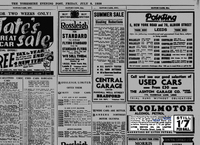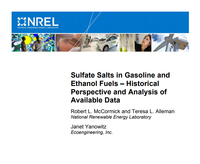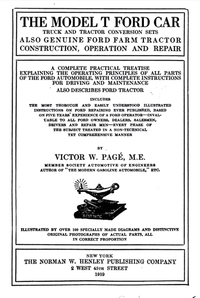The Hypocrisy of Big Oil and API
 |
hy•poc•ri•sy
/həˈpäkrəsē/ (alternate pronunciation /biɡ oil/)
noun 1.
the practice of claiming standards or beliefs to which one's own behavior does not conform.
synonyms: deceit, dishonesty, mendacity
ALERT... Prepare For A Shocking Information Discovery
By Marc J. Rauch
Exec. Vice President/Co-Publisher
THE AUTO CHANNEL
 Marc J. Rauch |
I came across a website titled "FillUpOnFacts.com." It's a website sponsored by the American Petroleum Institute (API) to bash ethanol. The hypocrisy begins with the website's name; the website is filled-up with lies.
This website lists 13 categories, and then links to details that API pretends are facts to support their bashing of ethanol. I provide a list of these categories below, along with my own previously published responses that explain why API is wrong on these issues.
However, without having to go through the 13 categories and my responses, there's a far easier way to prove the duplicity of Big Oil's attacks on ethanol.
For decades - while Standard Oil and other gasoline companies vehemently protested against ethanol fuels in the United States - Standard Oil, Cities Service (CITGO), and other American-based oil companies, sold ethanol-gasoline blends in Great Britain - where they marketed these fuels as being more powerful, cleaner, and cooler running.
In the 1920's, a consortium of scotch whisky distillers began producing and marketing an ethanol-gasoline blend for automobiles called "Discol." A few years later, the Discol name was licensed by another British company (Cleveland Petroleum Products) to sell an ethanol-gasoline blend, provided that Cleveland continued to use the alcohol produced by its distillers for the fuel blend. In the 1930's, Standard Oil (ESSO/Anglo-American Oil) purchased about half of Cleveland Petroleum Products. In 1958, ESSO purchased the remaining shares of Cleveland Petroleum.
The following are some of the print advertisements used to promote Cleveland Discol ethanol-gasoline fuel. The ads span the 1930's through the 1960's:
 Cleveland Discol ad 1934 |
 Cleveland Discol ad 1934 |
 Cleveland Discol ad 1935 |
 Cleveland Discol ad 1937 (Aviation Use!) |
 Cleveland Discol ad 1936 |
 Cleveland Discol ad 1937 |
 Cleveland Discol ad 1949 |
 Cleveland Discol ad 1954 |
 Cleveland Discol ad 1959 |
 Cleveland Discol ad 1960 |
 Cleveland Discol ad 1962 |
 Cleveland Discol ad 1964 |
 Cleveland Discol ad 1966 |
Here's a British television commercial from 1966 for Cleveland Discol ethanol-gasoline fuel:
Here's two British newspaper ads in the 1930's for Cities Service ethanol-gasoline blend called "Koolmotor."
 KoolMotor ad 1936 |
 KoolMotor ad 1938 |
As you see, the message told to the consumers in Great Britain about ethanol was far different than the story told to the American people, then and now. The benefits mentioned in the Discol ads include:
• Ethanol (alcohol) contributes to a brilliant performance and better mileage
• Engines run cooler and cleaner
• Ethanol has long been used to prevent icing in aircraft and car engines
• Amazing acceleration and smoother running
• More miles per gallon
• Highest anti-knock value
• It's thermal efficiency is higher than non-ethanol gasoline (BTUs are irrelevant)
• Less carbon is produced, ethanol actually removes carbon deposits
Great Britain wasn't the only place in Europe that sold ethanol or ethanol-gasoline blended fuels; alcohol was used extensively throughout Europe, South America, and Asia. Italy's brand was Benzacool, Hungary had Moltaco, Sweden had Lattybentyl, South Africa Natelite, Brazil's big brand was Alcool, and in the late 1930's America had an ethanol-gasoline blend called Agrol.
"The Forbidden Fuel," a book co-authored by William Kovarik, Hal Bernton, and Scott Sklar details the use of ethanol throughout the world. Bill Kovarik expands on all this through his Internet presentations, such as his History of Biofuels at Environmental history / biofuels.
In post-prohibition America, ethanol-gasoline fuels were often sold without all the boogeyman histrionics used by API members in recent years.
For example, in the 1970's, Texaco was producing an ethanol-gasoline blend and selling it in the United States. Here's a TV commercial from 1979 featuring Bob Hope promoting corn alcohol blended with gasoline.
Today, Canadians don't seem to know much about ethanol-gasoline blends. But here are 1984 and 1986 TV commercials from Mohawk gasoline stations in Canada. They sold an E10 ethanol-gasoline blend. It gave consumers "faster starts, more power, and cleaner emissions."
The great significance in all this is that prior to our modern Ethanol Renaissance (and production of vehicles with "ethanol-compatible components" starting in the 1990's) tens of thousands of vehicles... sorry, make that hundreds of thousands of vehicles... no, I mean millions of vehicles in Europe, the Americas, and Asia were powered by fuels that contained ethanol. On top of that, we have to assume other internal combustion engine devices (lawn mowers, chain saws, stationary machines) throughout the world used ethanol-gasoline blends at one time or another.
With all these millions of engines using ethanol-gasoline blends, where are all the newspaper/magazine reports of ethanol causing engine damage? Where are all the stories from the 1920's, 30's, 40's, 50's, and 60's screaming about ethanol corroding engine parts? Where are all the stories about ethanol causing less power and fewer miles per gallon? How could there not be hundreds, thousands, tens of thousands of published complaints that singled out ethanol as the evil-doer?
Of course, there wouldn't have been such stories sponsored by the oil companies since they were promoting the ethanol-gasoline blends as a superior fuel, but what about all know-it-all ethanol-haters who nowadays haunt and troll every publication and media outlet they can find with ethanol-horror stories. Surely there must have been empty-headed know-it-alls in those days insisting that because of ethanol's lower BTU values that it must deliver less power.
(Incidentally, in all the years up to the 1980's that the petroleum oil companies sold ethanol-gasoline they weren't "forced" to do it, there were no "ethanol mandates." They did it because it was the right thing to do. They did it because they knew that ethanol added power, cleaned the engines, emitted less pollution, and was the least expensive way to mitigate engine knock.)
A Remarkable Revelation
Well, a newly published report from the National Renewable Energy Laboratory (NREL) sheds some light on this subject, and at the same time throws some shade (as the young people say) on a possible suspect for the modern complaints against ethanol. Can you guess who that suspect is?
If you said "petroleum oil producers and blenders" you win a kewpie doll. Imagine, the oil industry causing the very same problems that they blame on ethanol; ain't that a kick in the head?
 |
The report is titled, "Sulfate Salts in Gasoline and Ethanol Fuels – Historical Perspective and Analysis of Available Data." It was published in September 2017, and can be found at https://www.nrel.gov/docs/fy17osti/69001.pdf.
Here's the thing, as I often say during my public speaking appearances, all liquids are corrosive, and one of the most corrosive liquids in the world is water. Water is so corrosive that if metals aren't treated or cared for, it could cause our largest aircraft carriers and biggest passenger jets to fall apart. Yet, we drink water, we wash in water, we even bathe new born babies in water. But because the corrosive characteristics of water can be overcome with appropriate materials, babies can go about 60 or 70 years before they start to corrode (yes, you're supposed to laugh at this point).
Gasoline is corrosive, too. Inhibitors are added to gasoline to reduce corrosion. Many, many people think that non-ethanol gasoline is some kind of benign fluid gently caressing engine components, and protecting the metal and rubber parts in some kind of an on-going mechanical love ballet.
Hah! Gasoline is a toxic, caustic, corrosive liquid.
 |
Unbeknownst to most people, especially those ethanol-bashers who wouldn't want to learn any real facts, prior to the invention of leaded-gasoline ethanol was considered the best substance to put in your vehicle's engine during long periods of inactivity. That's right, it was recommended to fill your vehicle's fuel tank and fuel system with ethanol fuel. In his 1919 maintenance manual for the Ford Model T (the world's number one selling automobile for almost two decades), Victor Page wrote, "Denatured alcohol (ethanol fuel) is without doubt the best substance to use as it does not have any destructive action on the metals and rubber hose, will not form deposits of foreign matter, and has no electrolytic effect." No literature of the period was ever published to refute that recommendation.
You can find Victor Page's manual at https://books.google.com/books?id=dqEgAAAAMAAJ. The above quote is located on the top of page 156.
When tetra-ethyl lead was added to gasoline by the General Motors scientists in the early 1920's it worked like ethanol in quieting engine knock. However it was highly corrosive, so they had to add ethylene dibromide to the gasoline-tetraethyl lead fuel mixture. Now they had a poison (gasoline), mixed with another poison (tetraethyl lead) in order to stop the engine knock caused by gasoline, with yet another poison (ethylene dibromide) to stop corrosion caused by tetraethyl lead. It's like a triple-threat poisonous concoction unleashed on the public by a science-fiction madman - except it really happened.
The advent of leaded-gasoline also led to changes in the design and manufacture of engine components to help handle this fuel. These changes probably were at least part of the reason why ethanol may have gone from being the harmless substance described by Victor Page to a potential corrosive fuel.
However, the new report released by NREL introduces the distinct possibility that the modern complaints of ethanol corrosion are the result of intentional or accidental monkeying with the ethanol-gasoline blends by the oil industry (or cronies of the oil industry) to denigrate ethanol.
Could the oil industry or its minions be responsible for this? Would they stoop to doing this?
Of course they would, trillions of dollars are at stake. The petroleum oil industry colluded with the Nazis before and during World War II in order to insure their position of dominance after the war in case the Allies lost. They're responsible for unleashing terrible poisons into our air and water. Oil wars have killed millions of Americans, and untold tens of millions of people around the world. Oil industry carelessness has killed millions of non-human animals of all types.
On the other hand, perhaps it's all just a coincidence? Perhaps the sheer competitive desire by the oil industry to keep their engine fuels the dominant engine fuels, even though there is a superior fuel (ethanol) at hand, just lends itself to circumstantial conjecture?
I can go with circumstantial conjecture. I don't think I need to paint a picture of premeditated death and destruction... as long as everyone understands that everything else I've written here isn't coincidence or circumstantial conjecture. Ethanol was the best fuel to use in internal combustion engines; it was the safest fuel to use in internal combustion engines; it provided the most power for internal combustion engines; and that ethanol is still the best, safest, most powerful fuel to use in internal combustion engines (spark ignited and compression ignited engines).
And now I'll return to the lies posed by the API website
FillUpOnFatcts.com indexes the following 13 issues. My replies can be found under the headings
The RFS Needs Reform
'Reform' suggests an evil act has been perpetrated. No one has committed more evil acts than the oil industry. Read "Why Does AAA and Big Oil Feel They Must Lie to America?" by
CLICKING HERE
The Cost of Mandates
The U.S. and our fellow citizens have been kept chained to oil for a century and a half via onerous taxation, an unpopular law of prohibition, military conscription, and never-ending tax-payer
subsidies. Read all about oil subsidies in Part 4 of my full-length report "Truth About Ethanol" by CLICKING HERE
The Reality of America's Energy Revolution
API is complaining that cellulosic ethanol hasn't yet come to fruition. Their argument is a ruse. They looking for something to complain about, like Chico Marx'
nonsensical add-on complaint in "Night At The Opera." He said, "Yeah, and your ice isn't cold enough."
It's not important that cellulosic ethanol isn't being used more, we have no shortage of ethanol or ethanol-crops. Here's my response to a Big Oil shill who complained that things are moving too slowly: CLICK HERE .
Outdated Supply and Demand Projections
API has built many of it's anti-ethanol arguments on outdated information and production techniques. The oil industry funded studies conducted by David Pimentel and Tad Patzek
are rife with rotten data. Read all about the Pimentel-Patzek sham studies in Part 5 of my full-length report "Truth About Ethanol" by CLICKING HERE.
Disconnect Between EPA Mandate and Technology
Read about the real disconnect. Taking On EPA, CAL Air Resources Board, Obama, and Big Oil.
What is the Blend Wall?
The Figurative Ethanol Blend Wall is a Fictional Ethanol Blend Wall.
E15 and Your Car
Big Oil E15 horror stories show up in the most remote places. To read about the debunking I did of one story CLICK HERE.
Fairytale Thinking on E85 and Ethanol Mandates
The fairytale thinking is in believing that E85 is limited to certain vehicles. All gasoline-powered automobiles can use E85, not just flex-fuel vehicles. Consumers
can 'splash-blend' their own blend levels to save money and get better MPG results. CLICK HERE to read "Using E85 in Non-Flex Fuel Vehicles Can Save Almost $1 per Gallon and Fight Terrorism."
The RFS is Bad Policy
We use as much corn for ethanol as we do because we grow it for ethanol production. If the ethanol market didn't exist farmers wouldn't grow as much corn as they do. Even with the
amount of corn that used for ethanol, we have virtually as much corn for human consumption as we did in the past. There is no shortage of pop corn, corn-on-the-cob for picnics, tortilla chips, or canned corn.
Read "Biofuels Are Worth Every Effort and Cost" for more details.
A Bumpy Ride for Motorcyclists
Motorcycles and Ethanol (E10) - The Shocking Truth.
Rising Ethanol Blends Don't Float All Boats
Mercury Marine, the world's largest manufacturer of marine engines likes E10 and thinks it's a better fuel than ethanol-free gasoline. To read/watch Mercury's
ethanol webinar CLICK HERE.
Outdoor Equipment and the RFS
One of the oil industry's most pernicious myths about ethanol concerns small engines. To read my take on ethanol and small engines CLICK HERE .
How Has the RFS Evolved Over Time?
You want to know how the RFS has evolved over time? Go to Los Angeles Airport and look north. On many, many days you can see the Hollywood Hills. In Pasadena you can look to the
west and south west and see the ocean. This wasn't true in the late 1980's and 90's.
• On February 14, 2018 I had the opportunity to present this paper in speech form at the Renewable Fuels Association NATIONAL ETHANOL CONFERENCE is San Antonio, Texas.
The following is the complete video of that presentation.



